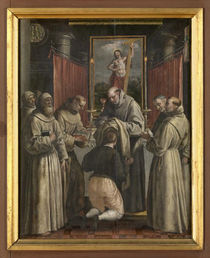The Catholic Defender: Saint Dominic "Veritas (truth)"
- Donald Hartley

- Aug 8
- 3 min read
Updated: Aug 8
Deepertruth with special permission and aid with Franiciscan Media, a great team for the Lord

If he hadn’t taken a trip with his bishop, Dominic would probably have remained within the structure of contemplative life; after the trip, he spent the rest of his life being a contemplative in active apostolic work.
Born in old Castile, Spain, Dominic was trained for the priesthood by a priest-uncle, studied the arts and theology, and became a canon of the cathedral at Osma, where there was an attempt to revive the apostolic common life described in Acts of the Apostles.
On a journey through France with his bishop, Dominic came face to face with the then virulent Albigensian heresy at Languedoc. The Albigensians–or Cathari, “the pure ones”–held to two principles—one good, one evil—in the world. All matter is evil—hence they denied the Incarnation and the sacraments. On the same principle, they abstained from procreation and took a minimum of food and drink. The inner circle led what some people regarded as a heroic life of purity and asceticism not shared by ordinary followers.
Dominic sensed the need for the Church to combat this heresy, and was commissioned to be part of the preaching crusade against it. He saw immediately why the preaching crusade was not succeeding: the ordinary people admired and followed the ascetical heroes of the Albigenses. Understandably, they were not impressed by the Catholic preachers who traveled with horse and retinues, stayed at the best inns and had servants. Dominic therefore, with three Cistercians, began itinerant preaching according to the gospel ideal. He continued this work for 10 years, being successful with the ordinary people but not with the leaders.
His fellow preachers gradually became a community, and in 1215 Dominic founded a religious house at Toulouse, the beginning of the Order of Preachers or Dominicans.
According to a Dominican tradition, in 1208 the rosary was given to Dominic in an apparition by the Blessed Virgin Mary in the church of Prouille.
Dominic was combating a popular heresy in France called Albigensianism. Mary gave him the rosary, told him to teach people this devotion, and promised that his apostolic efforts would be blessed with much success if he did.
A young man, the nephew of Stephen the cardinal of [Fossa Nuova monastery], fell with his horse into a ditch and was killed. Being lifted out, he was laid at the feet of Saint Dominic, who prayed over him and restored him to life.
Dominic’s ideal, and that of his Order, was to organically link a life with God, study, and prayer in all forms, with a ministry of salvation to people by the word of God. His ideal: contemplata tradere: “to pass on the fruits of contemplation” or “to speak only of God or with God.”
Saint Dominic is the patron saint of astronomers, scientists, falsely accused people and the Dominican Republic and other locales throughout the world. His feast day is August 8.
He founded the Order of Preachers. ...
His mother had a vision about his birth. ...
He is the patron saint of atronomers although not an. ...
He is depicted by artists with one or more attributes, ...
He was an Augustinian before establishing the.
His mother had a vision about Dominic's birth. ...
He sold his school textbooks for money to donate to the poor. ...
A road trip introduced him to his vocation. ...
Dominic is the patron saint of astronomers. ...
The founder of modern sculpture carved Dominic's shrine.
The evidence indicated that Dominic was a person of remarkable character and breadth of vision, he had the deepest compassion for human suffering, and he saw the need to use all the resources of learning in Christ's service. The canonization ceremonies were held on July 13, 1234.
The Dominican ideal, like that of all religious communities, is for the imitation, not merely the admiration, of the rest of the Church. The effective combining of contemplation and activity is the vocation of truck driver Smith as well as theologian Aquinas. Acquired contemplation is the tranquil abiding in the presence of God, and is an integral part of any full human life. It must be the wellspring of all Christian activity.
The lily–a traditional symbol of virginal purity–draws Dominican minds to a line from the O Lumen that calls our founder the “ivory of chastity.” Since we sing this chant nearly every night, the import of the efflorescent article in the statue's right hand is unmistakable: Dominic was a man of stalwart purity.
Dominic, who showed us the way to eternal happiness, and won many souls to God by founding the Order of Friars Preachers, pray for us, that we may follow in your footsteps, and ever work for the glory of God and the salvation of souls. Through Christ our Lord. Amen.





















Comments